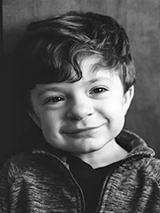Bone Marrow Transplant for Hurler Syndrome: Ethan’s Story
Bone Marrow Transplant for Hurler Syndrome: Ethan’s Story
When Children's Hospital of Philadelphia (CHOP) geneticists diagnosed Ethan with Hurler syndrome at 9 months old, his parents, Stephanie and Shawn, were plunged into an urgent and overwhelmed state. Hurler syndrome causes ongoing damage to cells, tissue and organs. The only treatment that can prevent further disease progression is a bone marrow transplant, which should be performed by a child’s first birthday, if not sooner. “Every day counted,” says Stephanie.

Ethan was born in 2015, and Stephanie and Shawn never could have imagined how much was riding on the fact that they lived in Texas at the time. Each state has a different set of diseases that are screened for at birth. Texas does not screen for Hurler syndrome, a rare disease that causes an abnormal accumulation of complex sugars in a child’s cells and, if left untreated, results in early childhood death.
Stephanie is a pharmacist and jokes that her medical knowledge “causes hypochondriac tendencies.” So when she noticed a little notch on Ethan’s lower spine at 3 months old, she wasn’t sure if she should worry. She showed her pediatrician and then, a few months later, brought Ethan to a pediatric orthopedic surgeon. The surgeon thought it was a birth defect that wouldn’t cause any harm. She was told that her son would live a perfectly normal life, he just couldn’t play football or join the military. Still, Stephanie was concerned as the curvature progressed.
In December, Shawn’s employer transferred him to New Jersey, and the relocated family decided that since they were now close to CHOP and its world-class care, they should get another opinion. They made an appointment with a pediatric orthopedic surgeon, who decided Ethan should get additional tests to make sure they weren’t missing a larger picture. An echocardiogram came back borderline abnormal, with no need of concern. Ethan then was seen by the Division of Human Genetics. The geneticist talked to Stephanie at length, took measurements and X-rays, and requested further genetic testing. “That’s when I was told they think he has Hurler syndrome,” says Stephanie. “The doctor said, ‘Don’t go home and Google this until we get the test results,’ but of course I did. That’s when I learned Hurler syndrome is considered a childhood disease because, before treatment, no one lived to adulthood.”
‘Not things you are prepared to deal with’
When Stephanie went to her appointment with the Metabolic Disease Program to get the genetic test results, all she could think was, “I am about to be told the most devastating news of my life.” Ethan did indeed have Hurler syndrome and would need a bone marrow transplant as soon as possible. “I needed to see 15 different specialists in the next two weeks,” Stephanie recalls. “They fast-tracked Ethan and scheduled everything for me — I can’t tell you how important that was. I was overwhelmed. These are not things you are prepared to deal with as a new mother.”
At this point, in addition to all the appointments, weekly enzyme replacement therapy infusions, and desperately waiting for the National Marrow Donor Program to locate a match, the family was still trying to find a home and get settled. “We were still in living in a temporary hotel or apartment and didn’t know anybody in the area,” says Stephanie. Finally, they found a home in Delaware that they would get ready to bring their son to after his transplant.
A bone marrow donor for Ethan was identified — and then fell through. “Every day counted,” says Stephanie. “The organ damage was ongoing.” Finally, a second donor was located, and Ethan had a lifesaving bone marrow transplant days before his first birthday. Although the procedure is not a cure, “It gives us 20 more years with our son — more I hope,” says Stephanie.
“While BMT does not prevent additional ophthalmologic and orthopedic issues, it does ameliorate other issues, including progressive neurologic decline and some cardiac issues,” explains Nancy Bunin, MD, Medical Director of the Blood and Marrow Transplant Program.
Finding a new level of strength
Ethan spent 45 days in the hospital, with Stephanie by his side: “I never left the room. One nurse would come in and say, ‘I’ve got him,’ and tell me to go take a shower, get something to eat. The nurses, doctors, therapists were all rooting for you. They became family.” Chaplain Laura Palmer, MDiv, BCC, visited every day. “She was such a tremendous support — I will never forget her kindness.”

Ethan pulled through. But the family was dealt another challenge when Ethan was diagnosed with autism. Now 5, Ethan is functionally nonverbal but making great progress with communication. “I’ve never had a conversation with him. I just try to make him happy,” explains Stephanie.
“Our family has taken hardships and grown from them,” she continues. “We feel a whole different level of strength.” When other families at CHOP are facing the same diagnosis, the clinical team connects them with Stephanie so they don’t feel so isolated. She takes every opportunity to give talks about rare diseases and the patient experience to students of various medical professions. She advocates on a state and national level for the rare disease community. She helped advocate for changing newborn screening programs to include Hurler syndrome and other rare disorders in her home state of Delaware.
“I want to make any difference I can,” she explains. “I want other families to know they aren’t alone and if I can help make their journey any easier — that’s what I will do.”